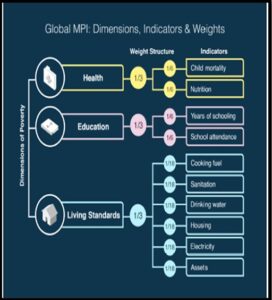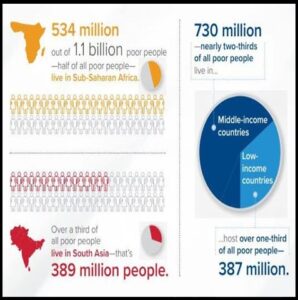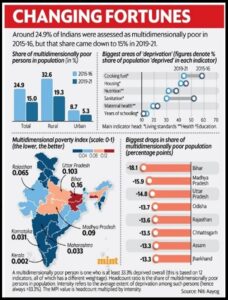MP INDEX REDUCTION UNDER THE NDA IS FLAWED
Syllabus:
- GS2 :Issues relating to Poverty and Hunger.
Issue in Focus:
- This article highlights the flawed nature of the Multidimensional Poverty Index (MPI) and its claims of significant poverty reduction in India under the NDA government.
- It is alleged that the official MPI estimates are misleading and do not reflect the actual ground reality.
The Global Multidimensional Poverty Index (MPI)
The Global Multidimensional Poverty Index (MPI) serves as a crucial international tool assessing severe multidimensional poverty in over 100 developing nations.
- Originating since 2010, Index is released jointly by the United Nations Development Programme (UNDP) and the Oxford Poverty and Human Development Initiative (OPHI).
- This index meticulously covers 3 dimensions across 10 indicators spanning health, education, and standard of living.
- It evaluates both the incidence and intensity of poverty.
Source: Health Notes
- The MPI’s global progress aligns with SDG 1, aiming to eradicate poverty universally. Additionally, it assesses intertwined deprivations spanning indicators associated with SDGs 1, 2, 3, 4, 6, 7, and 11.
- An individual is classified as multidimensional poor if deprived in one-third or more (equivalent to 33% or more) of the weighted indicators among the ten.
- Extreme multidimensional poverty is identified in those experiencing deprivation in one-half or more of the weighted indicators.
MPI Key Findings:
Global Outlook:
- 1 billion people (18% of the total population) globally live in acute multidimensional poverty.
- Sub-Saharan Africa has 534 million poor, and South Asia has 389 million, housing five out of six poor people.
- Children under 18 account for half of the 566 million MPI-poor people.
Outlook for India:
- India has over 230 million people in poverty, with 18.7% vulnerable to deprivations.
- India, among 25 countries, halved its global MPI values in 15 years, lifting 415 million out of poverty.
- Poverty incidence dropped from 55.1% in 2005/2006 to 16.4% in 2019/2021.
- Improvement in health, education, and standard of living indicators.
The Mint
Deprivation Indicators Improvement:
- India made significant progress in health, education, and standard of living.
- Poverty decline cuts across regions and socio-economic groups.
- Fastest absolute progress observed in the poorest states and groups.
- Percentage of multidimensionally poor and deprived of nutrition decreased from 44.3% (2005/2006) to 11.8% (2019/2021), and child mortality fell from 4.5% to 1.5%.
Why are official MPI estimates unreliable?
- Aggregated Weights: The National Multidimensional Poverty Index (MPI) under NITI Aayog and UNDP relies on aggregated and uniformly weighted components of health, education, and standard of living.
- Leaked poverty estimates based on the National Sample Survey (NSS)indicated a rise in poverty, contradicting the official MPI figures.
Arguments against the Official MPI Estimates:
- Unreliable Survey: The MPI relies on National Family Health Survey (NFHS) 4 and 5, which are not comprehensive enough and lack credibility. NFHS 5 was blocked due to its contradictory findings on open defecation, raising concerns about data manipulation.
- Misleading Reduction: The rapid decline in poverty reported by the MPI (from 24.85% to 14.96%) between 2015-16 and 2019-21 (i.e. exit of 135.5 million people from poverty) seems implausible.
- Questionable Source :The exclusion of the 75th Round of the NSS on household consumption expenditure from the MPI calculation raises questions about the data used.
- Impact of COVID-19: The havoc caused by the COVID-19 pandemic in 2020-21, leading to job losses, reverse migration, and economic challenges, is not adequately considered in the MPI estimates.
- Misinterpretation of Covariates: The analysis of covariates used in the MPI, such as per capita income, urban location, and health and education expenditure, reveals that these factors cannot explain the claimed rapid reduction in poverty.
- Discrepancies with Alternative Estimates: Independent estimates of the MPI, including ones for Uttar Pradesh, show a significant rise in poverty, contrary to the official claims of reduction.
Covariates Analysis
- Per Capita Income Impact: The largest reduction in MPI is attributed to higher per capita state income. However, since income decreased drastically, MPI spiked.
- Urbanization Effect: Urban location is a significant factor, with a 1% increase resulting in a 0.90% increase in MPI. This is linked to the growth of slums and sub-human living conditions in urban areas.
- Health and Education Expenditure: Higher health and education expenditure is associated with lower MPI, but a decline in educational expenditure at the state level contributes to a potential rise in MPI.
- Criminal MP Influence: States with a higher share of Members of Parliament with criminal cases tend to have higher MPI, indicating corruption and misallocation of funds.
Contradictory State-Level Findings
- Selective Review: A selective review of MPI estimates reveals rising poverty in Uttar Pradesh and varying trends in states that went to elections in November, challenging the overall narrative of a significant reduction.
- Discrepancies in Reduction: State-level estimates, compared to official claims, suggest a lower reduction in MPI between 2015 and 2019-21, raising questions about the accuracy of the national MPI reduction.
Way Forward:
- Consider conventional income-based measures of poverty alongside the MPI for a more comprehensive understanding of the issue.
- Aggregation of diverse capabilities into a single MPI score must be avoided as it overlooks the unique needs and challenges of different individuals and groups.
- More transparent and reliable data collection process for poverty assessment and for a greater focus on addressing the root causes of poverty, such as corruption and inadequate public services.
Mains Practice Question:
Discuss the key findings of the recent Multidimensional Poverty Index (MPI) and Critically evaluate the claim of significant poverty reduction in India based on the recent Multidimensional Poverty Index (MPI).

 Source: Health Notes
Source: Health Notes
 The Mint
The Mint

